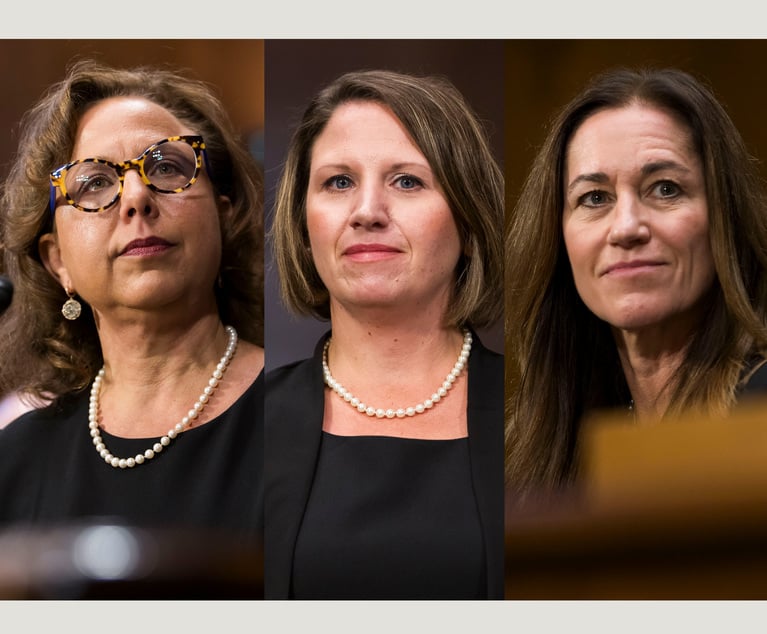Third Circuit Establishes New Analysis for Cramdown Cases
In In re Tribune, 972 F.3d 228 (3d Cir. 2020), the U.S. Court of Appeals for the Third Circuit affirmed the confirmation of Tribune Co.'s Chapter 11 plan. In so doing, the court identified certain principles to be applied when determining whether a plan unfairly discriminates against a dissenting class of creditors.
February 11, 2021 at 12:14 PM
8 minute read
 From left: Elisa Hyder and Rudolph J. DiMassa Jr. of Duane Morris.
From left: Elisa Hyder and Rudolph J. DiMassa Jr. of Duane Morris.
Introduction
In In re Tribune, 972 F.3d 228 (3d Cir. 2020), the U.S. Court of Appeals for the Third Circuit affirmed the confirmation of Tribune Co.'s Chapter 11 plan. In so doing, the court identified certain principles to be applied when determining whether a plan unfairly discriminates against a dissenting class of creditors. In particular, the court established a new eight-step analysis to be applied in "cramming down" such a dissenting class pursuant to Section 1129(b)(1) of the Bankruptcy Code.
Factual Background
Tribune, the largest media conglomerate in the country, filed for bankruptcy in 2008 and proposed a Chapter 11 plan that separated its various unsecured creditors into distinct classes. Under the plan, certain senior noteholders (whose unsecured claims totaled over $1 billion) comprised creditor "Class 1E," and certain other unsecured creditors constituted "Class 1F." Pursuant to Tribune's prepetition loan agreements, Tribune and its lenders agreed that certain senior obligations would be satisfied in full before any other unsecured creditor would receive payment on account of its debt. The plan provided that both Class 1E and Class 1F creditors were to receive 33.6 percent of their outstanding claims. The senior noteholders objected, arguing that the allocation of payments to Class 1F under the plan violated Tribune's subordination agreements and unfairly discriminated against them as Class 1E creditors.
The U.S. Bankruptcy Court for the District of Delaware examined section 1129(b)(1) of the Bankruptcy Code, the "cramdown provision," to determine whether it could confirm Tribune's plan over the senior noteholders' dissent. The bankruptcy court first concluded that the senior noteholders' claims and a portion of Class 1F's claims qualified as senior obligations. Accordingly, and pursuant to the parties' prior stipulations, were the prepetition subordination agreements to be strictly enforced, the senior noteholders' recovery would have been 34.5%, as compared to the 33.6% recovery they would actually receive under the plan. The court concluded that the difference between Class 1E's desired and actual recovery—nine-tenths of a percentage point—was immaterial, and confirmed the plan over Class 1E's objection. The U.S, District Court for the District of Delaware affirmed the decision of the bankruptcy court, and the senior noteholders appealed that decision to the U.S. Court of Appeals for the Third Circuit.
This content has been archived. It is available through our partners, LexisNexis® and Bloomberg Law.
To view this content, please continue to their sites.
Not a Lexis Subscriber?
Subscribe Now
Not a Bloomberg Law Subscriber?
Subscribe Now
NOT FOR REPRINT
© 2025 ALM Global, LLC, All Rights Reserved. Request academic re-use from www.copyright.com. All other uses, submit a request to [email protected]. For more information visit Asset & Logo Licensing.
You Might Like
View All
Pa. Federal District Courts Reach Full Complement Following Latest Confirmation

The Defense Bar Is Feeling the Strain: Busy Med Mal Trial Schedules Might Be Phila.'s 'New Normal'
7 minute read
Federal Judge Allows Elderly Woman's Consumer Protection Suit to Proceed Against Citizens Bank
5 minute read
Judge Leaves Statute of Limitations Question in Injury Crash Suit for a Jury
4 minute readLaw Firms Mentioned
Trending Stories
- 1A Message to the Community: Meeting the Moment in 2025
- 2Ex-Prosecutor Denies on Witness Stand That She Tried to Protect Ahmaud Arbery's Killers
- 3Latham's Lateral Hiring Picks Up Steam, With Firm Adding Simpson Practice Head, Private Equity GC
- 4Legal Restrictions Governing Artificial Intelligence in the Workplace
- 5Failure to Adequately Inform Patients
Who Got The Work
J. Brugh Lower of Gibbons has entered an appearance for industrial equipment supplier Devco Corporation in a pending trademark infringement lawsuit. The suit, accusing the defendant of selling knock-off Graco products, was filed Dec. 18 in New Jersey District Court by Rivkin Radler on behalf of Graco Inc. and Graco Minnesota. The case, assigned to U.S. District Judge Zahid N. Quraishi, is 3:24-cv-11294, Graco Inc. et al v. Devco Corporation.
Who Got The Work
Rebecca Maller-Stein and Kent A. Yalowitz of Arnold & Porter Kaye Scholer have entered their appearances for Hanaco Venture Capital and its executives, Lior Prosor and David Frankel, in a pending securities lawsuit. The action, filed on Dec. 24 in New York Southern District Court by Zell, Aron & Co. on behalf of Goldeneye Advisors, accuses the defendants of negligently and fraudulently managing the plaintiff's $1 million investment. The case, assigned to U.S. District Judge Vernon S. Broderick, is 1:24-cv-09918, Goldeneye Advisors, LLC v. Hanaco Venture Capital, Ltd. et al.
Who Got The Work
Attorneys from A&O Shearman has stepped in as defense counsel for Toronto-Dominion Bank and other defendants in a pending securities class action. The suit, filed Dec. 11 in New York Southern District Court by Bleichmar Fonti & Auld, accuses the defendants of concealing the bank's 'pervasive' deficiencies in regards to its compliance with the Bank Secrecy Act and the quality of its anti-money laundering controls. The case, assigned to U.S. District Judge Arun Subramanian, is 1:24-cv-09445, Gonzalez v. The Toronto-Dominion Bank et al.
Who Got The Work
Crown Castle International, a Pennsylvania company providing shared communications infrastructure, has turned to Luke D. Wolf of Gordon Rees Scully Mansukhani to fend off a pending breach-of-contract lawsuit. The court action, filed Nov. 25 in Michigan Eastern District Court by Hooper Hathaway PC on behalf of The Town Residences LLC, accuses Crown Castle of failing to transfer approximately $30,000 in utility payments from T-Mobile in breach of a roof-top lease and assignment agreement. The case, assigned to U.S. District Judge Susan K. Declercq, is 2:24-cv-13131, The Town Residences LLC v. T-Mobile US, Inc. et al.
Who Got The Work
Wilfred P. Coronato and Daniel M. Schwartz of McCarter & English have stepped in as defense counsel to Electrolux Home Products Inc. in a pending product liability lawsuit. The court action, filed Nov. 26 in New York Eastern District Court by Poulos Lopiccolo PC and Nagel Rice LLP on behalf of David Stern, alleges that the defendant's refrigerators’ drawers and shelving repeatedly break and fall apart within months after purchase. The case, assigned to U.S. District Judge Joan M. Azrack, is 2:24-cv-08204, Stern v. Electrolux Home Products, Inc.
Featured Firms
Law Offices of Gary Martin Hays & Associates, P.C.
(470) 294-1674
Law Offices of Mark E. Salomone
(857) 444-6468
Smith & Hassler
(713) 739-1250





